We certainly hope that you enjoy this article featuring 7 Spectacular Herbaceous Plants of the World. Certainly, herbaceous plants exist in virtually all parts of the world. However, not all of them stand out from the rest as these few do. These particular plants stand apart from the majority of others for a variety of differing reasons. But they all have one thing in common, they never cease to fascinate us.
Rose of Jericho
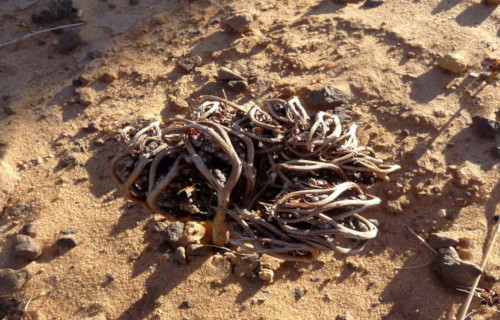
CCL: http://bit.ly/2REt4fw
Rose of Jericho Facts
- The first of our 7 Spectacular Herbaceous Plants of the World is the amazing species known as the Rose of Jericho.
- First of all, the attention-grabbing name serves as the much more pronounceable term for an incredible plant. That’s because it’s the common name for the rather fascinating Anastatica hierochuntica.
- Secondly, this remarkable plant also remains renowned among researchers for one particular reason. This fascinating species holds this status due to its truly astonishing resistance to desiccation.
- In addition, the plant remains considered by many experts in the field to represent an extremely hardy form of a surprising type of plant. This bewildering species technically represents a type of tumbleweed.
- Furthermore, in ancient times, it had a very specific and highly beneficial usage. During that era, a wise man or shaman actually often used this plant as a means of predicting if rain was imminent.
- But, for the moment, the IUCN does not yet have a classification for this rather interesting species. This holds true due to the fact that, for the moment, at least, its numbers appear to be relatively stable.
Rose of Jericho Physical Description
Perhaps most notably, although remarkable, and visually rather distinctive, the Rose of Jericho nevertheless remains a small species of plant. But, what the plant lacks in terms of size, it easily makes up for in distinctiveness.
Nevertheless, even truly exceptional individual specimens rarely achieve a height of more than 6 in (15 cm). Moreover, most individual plants actually attain a somewhat smaller overall size than that, usually about 4 in 10 cm).
Additionally, it also, and once again, surprisingly, represents a type of annual herb. In appearance, this marvelous work of Nature most commonly displays a light gray in color, and produces small white flowers.
But, while quite small, the seeds of this highly adapted plant remain far from fragile. In fact, these remain extremely hardy and well protected by the surrounding leaves, thereby serving to ensure continuance of the species.
- Kingdom: Plantae
- Phylum: Angiosperms
- Class: Eudicots
- Order: Brassicales
- Family: Brassicaceae
- Genus: Anastatica
- Species: A. hierochuntica
Rose of Jericho Distribution, Habitat, and Ecology
Firstly, the rather incredible Rose of Jericho evolved its sincerely astonishing hardiness and regenerative abilities for a specific reason. This is completely understandable, because of the severity of its native climate.
Secondly, it also evolved as endemic to the extremely arid regions of Asia. It most commonly occurs in the countries of the Middle East and the Sahara. To date, it remains unknown if it ever appeared anywhere else.
Even more specifically, this highly evolved species only inhabits the various desert regions of eight modern countries. These locations consist solely of Egypt, Iran, Israel, Palestine, Jordan, Syria, Iraq, and Pakistan.
The amazing Rose of Jericho also dries up virtually completely after the end of the local rainy season. At that time, the leaves of each individual plant contract tightly, thereby protecting the precious seeds.
Finally, it can also actually lie dormant for months or even years, presenting a highly convincing appearance of death. Yet, when the rain finally comes, it opens quickly, to receive the life-giving water.
Doll’s Eye
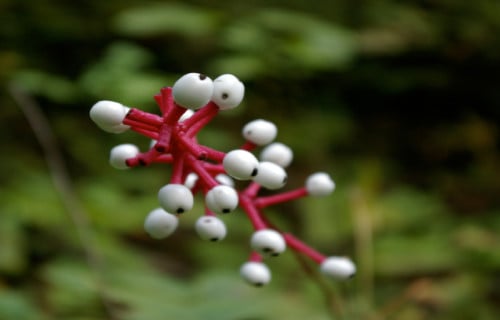
CCL: http://bit.ly/2xQPH8p
Doll’s Eye Facts
- Next up in this listing of 7 Spectacular Herbaceous Plants of the World is one that really catches the eye, the amazing Doll’s Eye.
- Most notably, this plant remains a highly unique and rather distinctive species, to say the least. It also remains a flowering plant, endemic to only a few of the eastern regions of the continent it evolved on.
- Furthermore, this incredibly fascinating plant evolved as closely related to the baneberry. In addition, it typically typically blooms during the period lasting from early May to mid-June.
- The remarkable herbaceous species also generally grows in remote areas and extremely rugged terrain. Quite unfortunately, this tendency usually makes it rather difficult for researchers to locate. Therefore, due to insufficient data, the IUCN has no listing for it.
- Finally, the unusual common name derives directly from the highly distinctive, and to many, unforgettable, physical appearance of the multiple small fruits. Many find these to look like the eyes of dolls, thus the term.
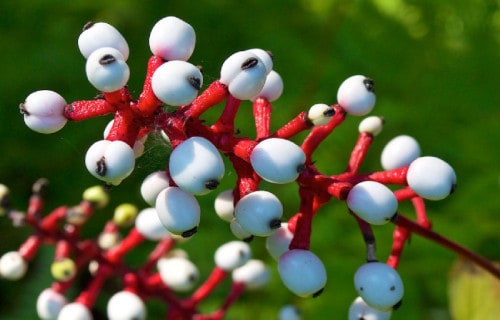
CCL: http://bit.ly/2OUHszC
Doll’s Eye Physical Description
First of all, the Doll’s Eye developed as a herbaceous perennial species, regardless of its astonishing appearance. However, despite its impressive appearance, it nonetheless ranks as only a moderate-sized plant, compared to related species.
That holds true because typical individuals of this remarkable small species only measure about 24 in (61 cm) in height. Furthermore, the width of each individual averages around 36 in (91 cm). This represents a rather common ratio.
Also, the leaves generally appear rather broad, being almost as wide as long. Additionally, the flowers develop small and white in color. These rarely grow to more than 0.2 in (5 m) in length. But, it’s the berries that give the plant its uniquely distinctive appearance.
- Kingdom: Plantae
- Phylum: Angiosperms
- Class: Eudicots
- Order: Ranunculales
- Family: Ranunculaceae
- Genus: Actaea
- Species: A. pachypoda
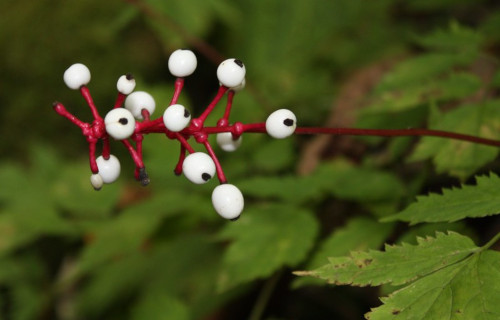
CCL: https://bit.ly/37Msrtl
Doll’s Eye Distribution, Habitat, and Ecology
Firstly, the Doll’s Eye appears mainly in the southern portions of the United States, in North America. The fascinating plant usually develops in rather dense forests. It also seems to prefer the indirect light typical of such settings.
Furthermore, it generally appears in comparatively coarse soil or even clay. It also thrives in the densest sections of forests. Yet, it does not display a particular preference for forest types, living in both hardwood and mixed forest types.
It also evolved as a moderately toxic plant. The entire plant remains poisonous to humans. Birds, however, appear to be immune to the toxins. As a result, many species of native birds actually thrive on the plant.
However, the greatest concentration of toxin appears to be contained within the unique looking berries. In a relatively common development, these slowly ripen during the summer, growing steadily more toxic over time.
Finally, the toxins of the Doll’s Eye are cardiogenic in nature. The chemicals they contain have an almost immediate sedating effect upon the muscles of the human heart. If consumed in sufficient quantity, the effect can be fatal.
Hooker’s Lips
Hooker’s Lips Facts
- Our third selection for inclusion in this compendium of 7 Spectacular Herbaceous Plants of the World is the remarkable Hooker’s Lips.
- Most notably, this fascinating plant only maintains this unique shape for a brief time. However, believe it or not, the highly distinctive shape actually does serve an important purpose.
- In addition to being a conversation starter, the species plays its own vital role in its environment. That holds true because it remains one of the few acceptable host plants for the rare golden silk moth.
- The inhabitants of its endemic range have also discovered multiple uses for the species. Given its rather unique form, it makes a popular gift Valentine’s Day. Various parts of the tree have also been discovered to have medicinal properties.
- Sadly, It has become highly endangered. It was moderately rare, to begin with. Now, its numbers and range have both been severely diminished by climate change and habitat loss.
Hooker’s Lips Physical Description
Firstly, though the Hooker’s Lips plant technically must be called a tree, it forms a rather diminutive one. This holds true due to the fact that this most unusual species rarely exceeds 10 ft (3 m) in height.
Further, the trunk grows comparatively thin. As a result, it often becomes bent slightly from the weight of the foliage. Likewise, the leaves of the species also grow comparatively long and thick in design.
The most noteworthy feature of the tree consists, obviously, of the bright red lip-like structure. These actually consist of bracts that form temporarily, prior to the appearance of the flowers.
Additionally, the unique shape favors the hummingbirds that serves as its primary pollinator. While the bracts present as red, the flowers show a bright white in color. This further adds to the attraction for pollination.
Due to the range in which it developed, the trees bloom from December to March. The flowers also become quite aromatic in nature. The berries that appear after the flowers stay small and dark blue or black.
- Kingdom: Plantae
- Class: Angiosperm
- Order: Gentianales
- Family: Rubiaceae
- Genus: Psychotria
- Species: Psychotria elata
Hooker’s Lips Distribution, Habitat, and Ecology
The astounding Hooker’s Lips evolved endemically to a specific portion of both South and Central America. This range principally includes the countries of Costa Rica, Ecuador, Panama, and Colombia.
First of all, the deep portions of the rainforest comprise the native environment of the unusual plant. But, while the tree evolved as a tropical species, it has proven adaptable to temperate climates.
In addition to its visual appeal, the plant has provided several medicinal uses. Local inhabitants have learned to make use of both the bark and leaves. These can be used to treat coughs, earaches, and skin rashes.
Also, the indigenous Kuna Indians have traditionally used the plant for treating dyspnea.
Unfortunately, the species’ numbers appear to be decreasing quickly. This seems to be occurring due to the ongoing rainforest deforestation. As a result of this, its available habitat has greatly diminished.
Happy Alien
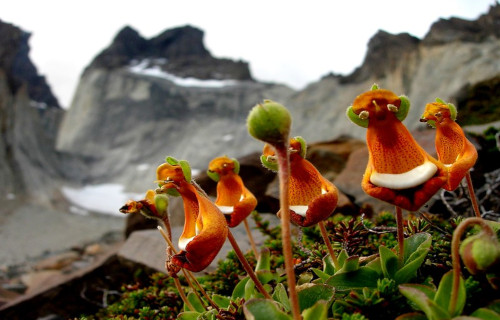
CCL: https://bit.ly/33p6Jsa
Happy Alien Facts
- Listing next among our choices of 7 Spectacular Herbaceous Plants of the World is one that seems as if it’s from another, the Happy Alien.
- First of all, the term Happy Alien actually does serve as the common name of this astounding plant. It also ranks as a most unusual species. Quite understandably, its common name derives from the unique appearance of its blooms.
- Furthermore, it grows naturally in only one location in the world. However, it eventually spread, presumably due to human activity. As a result, it now appears in Chile and Argentina. But, for now, it only appears there in scattered locations.
- In addition, it was Charles Darwin himself who officially discovered it. This amazing discovery occurred during his 1831-1836 expedition. But, other individuals previously described it unofficially as early as 1791.
- For the moment, the IUCN it does not yet list it on its Red List of Threatened Species. However, its restricted range does make it vulnerable. Its potential threats include habitat loss and climate change.
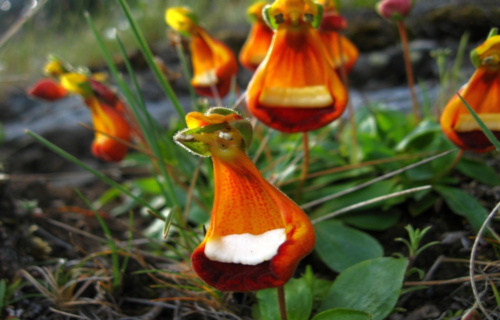
CCL: https://bit.ly/2qQiydy
Happy Alien Physical Description
Firstly, the highly distinctive looking Happy Alien holds a somewhat unusual, though not unknown, status. That’s because botanists classify this truly surprising small plant as both an evergreen and a perennial species.
Secondly, a fully grown plant rarely exceeds 5 in (12.7 cm) in height. Also, the leaves likewise stay small and produce a decidedly tongue-shaped structure. Similar to most other alpine plants, this plant possesses a relatively shallow system of roots.
However, the lovely and distinctive flowers constitute its most unique feature. They seem pouch-like in shape and grow to roughly 2 in (5 cm) in length. The shape of this feature serves as the source of its name.
These typically develop primarily orange-yellow in color. However, combinations of red shades present develop on parts of the bloom, as well. These grow on short, slender stems, with a white band also being present on the mouth.
- Kingdom: Plantae
- Phylum: Angiosperms
- Class: Eudicots
- Order: Lamiales
- Family: Calceolariaceae
- Genus: Calceolaria
- Species: C. uniflora
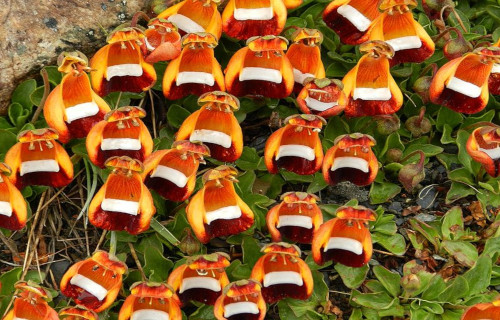
CCL: https://bit.ly/37CYYlH
Happy Alien Distribution, Habitat, and Ecology
Most notably, though it spread via the actions of man, the remarkable Happy Alien evolved as native only to a highly isolated range. That’s because this little charmer originally grew only in the archipelago of Tierra del Fuego, in South America.
The Happy Alien evolved as a cold climate mountain species. Its typical habitat includes a wide range of types, however, as long as these stay open and well drained. These include coastal rock and sand regions, scrubland, moors, cliffs, and steppes.
Furthermore, the appropriately named blooms appear throughout the summer. Its abundant fruits consist of small capsules. However, unlike most blooming plants, this species attains pollination through birds, rather than by insects.
Finally, its aromatic blooms draw multitudes of birds to feed on the uncolored band. In the process, these collect its pollen, which then gets transmitted to the next flower the animal visits, ensuring its propagation.
Bulbpphyllum phalaenopsis
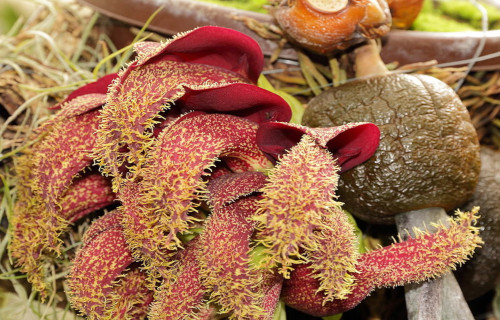
CCL: https://bit.ly/1p2b8Ke
Bulbophyllum phalaenopsis Facts
- The fifth of our 7 Spectacular Herbaceous Plants of the World, may have a name you would like to forget, but you will never forget the plant itself.
- First of all, the bizarre appearance of the unique Bulbophyllum phalaenopsis conceals a truly surprising fact. That’s because this visually unappealing plant with no common name actually constitutes a type of orchid.
- Further, the astonishing species also sets itself apart from related plants in yet another disturbing fashion. That distinction occurs due to a rather unusual fact. That’s because it also ranks as the worst smelling of all known orchids.
- In addition, it inhabits a highly restricted and remote region. As a result, few people know of its existence. However, despite the inherent dangers of a small range, the IUCN currently does not have a listing for it on the Red List.
- Finally, it also faces several threats to its continued existence. Obviously, its comparatively tiny habitat range only serves to augment these. Its major threats include the same as many other species, climate change and habitat loss.
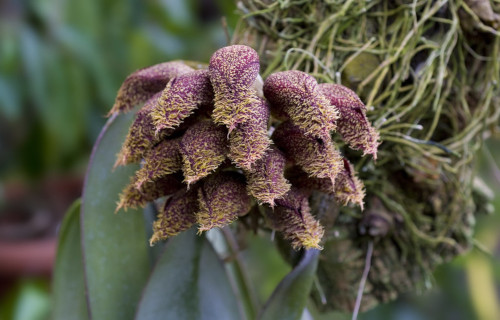
CCL: https://bit.ly/1iowB8m
Bulbophyllum phalaenopsis Physical Description
Firstly, the truly incredible Bulbophyllum phalaenopsis distinguishes itself in yet another way from others of its kind. That’s because the plant attains a truly impressive size for an orchid. In fact, it ranks as one of the largest of all known varieties.
But, that size does not apply in the vertical sense. Most individuals specimens only reach a height of about 12 in (30 cm). However, its remarkable leaves often achieve a length of roughly 4 ft (1.22 m). These, therefore, drape along the ground in the wild, or drape down if the plant is hung above the ground.
Furthermore, its flowers typically appear in relatively large clusters. These impressive groupings typically reach a length of about 2.4 in (6.2 cm), and display parallel sepals. Each usually shows a purplish-red color with yellow spots, and a covering of dense hairs.
- Kingdom: Plantae
- Phylum: Angiosperms
- Class: Monocots
- Order: Asparagales
- Family: Orchidaceae
- Genus: Bulbophyllum
- Species: B. phalaenopsis
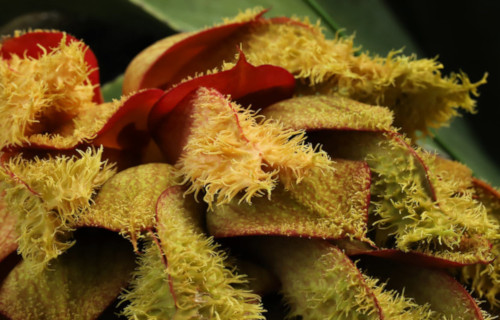
CCL: https://bit.ly/1iowB8m
Bulbophyllum phalaenopsis Distribution, Habitat, and Ecology
Most notably, the startling, yet sincerely fascinating Bulbophyllum phalaenopsis only appears in Nature in on isolated area of the world. That particular region consists solely of Papua, New Guinea, near Australia.
Additionally, the amazing plant only naturally inhabits a particular portion of the rather large island. That limited area consists only of sections of lowland forests, at elevations of no more than 1,640 ft (500 m).
Also, like some other types of orchids, this unforgettable variety blooms not just once per season, but year round. But perhaps its most notable feature remains its powerful odor, often compared to the stench of rotting meat.
This unpleasant odor, however, serves a useful purpose in Nature. That’s because it serves to attract copious numbers of a specific type of insect. Unlike many flowers, the Bulbophyllum phalaenopsis is pollinated by carrion flies, instead of bees.
Naked Man Orchid
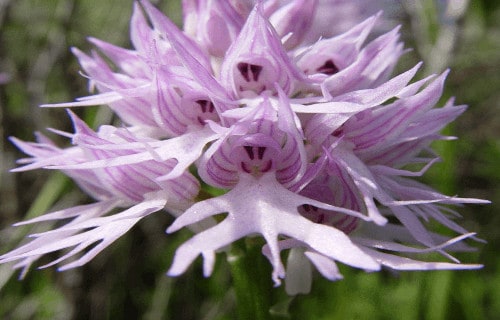
CCL: https://bit.ly/1p2b8Ke
Naked Man Orchid Facts
- The next eye-catching entry on our lit of 7 Spectacular Herbaceous Plants of the World is the fabulous Naked Man Orchid.
- Firstly, the Naked Man Orchid forms a rather unusual species of orchid, to say the least. Most notably, this image does not include photoshopping and shows exactly why the remarkable plant bears its common name.
- Further, this astonishing flower also remains one of the fortunate ones, compared to many related species. Due to having a sufficient population, it currently lists with the IUCN as a Species of Least Concern.
- However, while it does not rank as endangered at this time, that could change in the very near future. That’s because, quite sadly, the known numbers of the species appear to be declining rapidly, for a variety of reasons.
- Finally, regardless of the current listing of this special species, all orchid varieties are now protected. This protection comes in the form of the Convention on International Trade in Endangered Species of Wild Fauna and Flora (CITES).
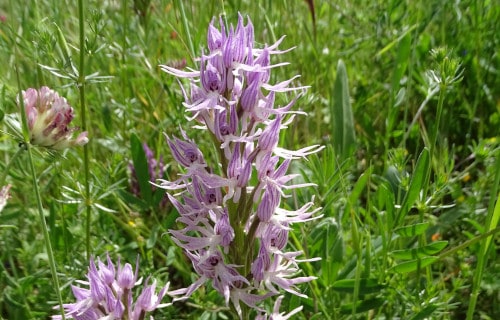
CCL: http://bit.ly/2JszWtI
Naked Man Orchid Physical Description
Firstly, the most obvious characteristic of the Naked Man Orchid remains the over-sized lobed lip of every flower. By a rather surprising, and amusing quirk of Nature, this vaguely resembles the general shape of a naked man.
Also, the truly remarkable plant produces a single, comparatively thick stalk. Further, this feature typically attains a height of roughly 20 in (50 cm). In addition, several short, light green leaves may also be present on occasion.
The uniquely shaped flowers of this hermaphroditic plant also appear in comparatively large clusters. Additionally, these most often present varying shades of pink. Furthermore, two dark circles resembling eyes also develop.
But, in a surprising twist of Nature, not every bloom displays the eye-like spots. The reason some do while some do not presently remains a mystery. Further, the plant also produces numerous tubers, which are edible.
- Kingdom: Plantae
- Phylum: Angiosperms
- Class: Monocots
- Order: Asparagales
- Family: Orchidaceae
- Genus: Orchis
- Species: O. italica
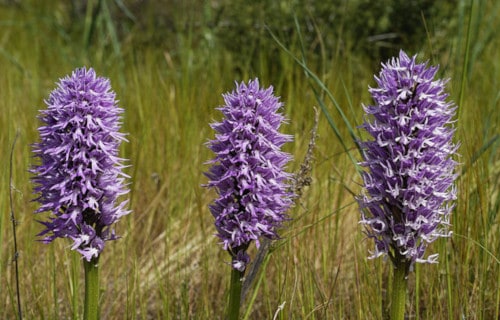
CCL: http://bit.ly/2IjEG4n
Naked Man Orchid Distribution, Habitat, and Ecology
The Naked Man Orchid developed as native to the Mediterranean region. The Orchis italica occurs in a large part of that area. This includes Portugal, Spain, Italy, Serbia, Greece, the Aegean islands, Turkey, Cyprus, Malta, Syria, Jordan, and also northern Africa.
Additionally, it also grows at altitudes of up to 4,300 ft (1,300 m), and typically prefers areas of direct sunlight. In addition, the plant also flourishes quite well in a wide range of soil types. This holds true as long as it has adequate drainage.
The incredible Orchis italica also most commonly appears in fertile meadows or regions of light forests. Finally, this astounding plant typically blooms between the months of March and May and usually grows in large groupings.
Skeleton Flower
Skeleton Flower Facts
- The last, but absolutely not the least, of our selections of 7 Spectacular Herbaceous Plants of the World is the breathtaking Skeleton Flower.
- Most notably, this lovely and rather interestingly named plant goes by the distinctive common name. Also known by the scientific name of the Diphylleia grayi, it represents a fascinating and extraordinary plant genus.
- Additionally, it also carries with it a truly remarkable secret. Due to the quite unique chemical composition of its pigmentation, an incredible transformation quickly occurs when the petals become wet.
- That fact holds true because the pigmentation of the flower itself rapidly fades away. Therefore, the already delicate-seeming petals actually become almost completely transparent, thus the common name.
- Finally, once these completely dry, the petals of the Skeleton Flower undergo yet another incredible transformation. At this time, they once again regain their original coloring, completing the breathtaking transformation.
Skeleton Flower Physical Description
First of all, the truly amazing Skeleton Flower evolved as a deciduous perennial that dies in winter. Also, it develops comparatively large, umbrella-shaped leaves. In addition, these leaves typically appear topped with clusters of the unique blooms.
Furthermore, in summer the petals of this fascinating species rapidly fall away. But not to worry, because Nature quickly replaces them. At that time, the remarkable plant develops copious quantities of bright blue colored berries.
However, despite its otherwise remarkable nature, it remains only an average sized plant of its type. That’s because the visually stunning angiosperm generally attains a height of about 15.75 in (40 cm) and a width of just over 3 ft (1 m) across.
- Kingdom: Plantae
- Phylum: Angiosperms
- Class: Eudicots
- Order: Ranunculales
- Family: Berberidaceae
- Genus: Diphylleia
- Species: D. grayi
Skeleton Flower Distribution, Habitat, and Ecology
The rather awesome Skeleton Flower evolved as endemic solely to a specific portion of the continent of Asia. Further, within that region, it primarily grows naturally in the colder regions of what now constitutes the countries of China and Japan.
However, an incredible mystery also surrounds this incredible plant that experts have no explanation for. Members of the genus also appear in isolated portions of the Appalachian Mountains of the United States, in North America.
Additionally, it also displays a decided preference in its choice of habitats, much as many other species do. As a result of this selectivity, the Skeleton Flower primarily appears in areas consisting of rather moist, wooded mountain regions.
This truly visually distinctive and remarkable species also evolved to bloom later than some related species. That fact holds true because it typically produces its lovely flowers in the later portions of spring, and through early summer.
Finally, and not surprisingly, the lovely flowering plant also remains quite sensitive to sunlight. In fact, it flourishes best in shaded areas, with little or no direct sun. It also thrives better in regions of moderate temperature extremes.

CCL: https://bit.ly/1p2b8Ke
7 Spectacular Herbaceous Plants of the World
We sincerely hope that you have enjoyed reading and learning about these 7 Spectacular Herbaceous Plants of the World. Obviously these represent only the tiniest fraction of the fabulous similar plants around the world. We encourage you to learn all that you can about as many of them as possible. We also encourage you to join us and others in doing all that we can to preserve all forms of life on this planet. Sadly, many now find themselves in dire need of our help.
Check out our other articles on Breathtaking Primates of the World, 8 Truly Monumental Orchids, 5 Phenomenal Sea Turtles, Spectacular Dolphins Throughout Our World
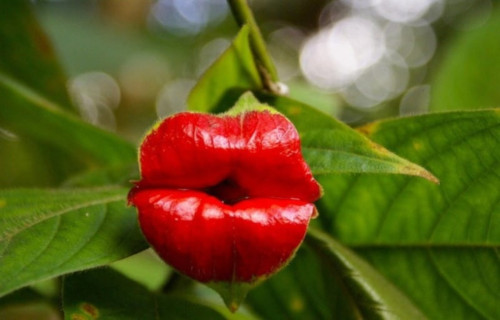
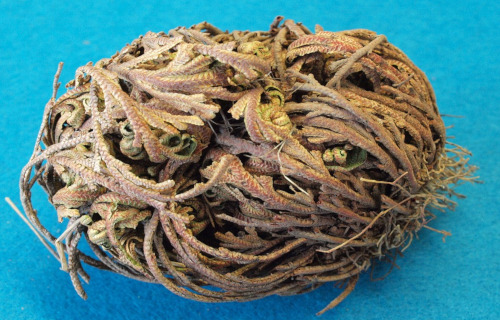
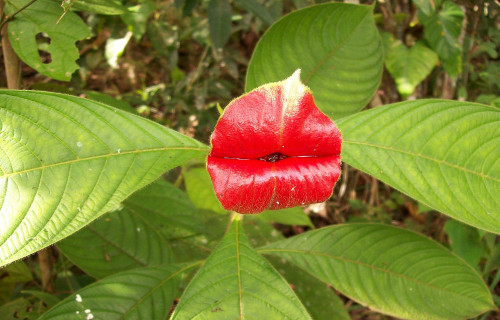
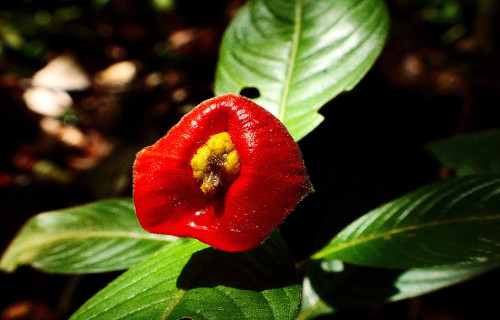
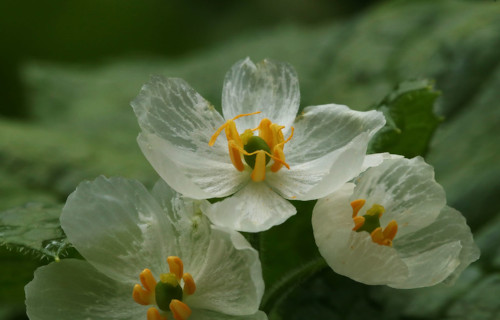
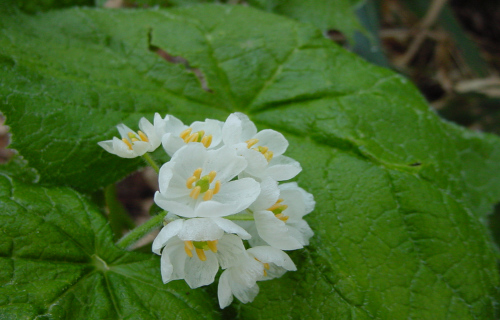
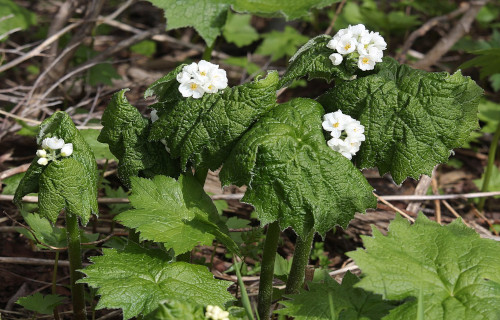









Leave a Reply